From complex tapestries to innovative light installations, exceptional works were once again on show this year at the renowned Salone del Mobile fair in Milan. The TextielLab provided fertile ground for the creation of these unique pieces by both established and emerging artists and designers. Read in the overview below how the combination of craftsmanship and modern techniques resulted in a wide variety of works.
The intriguing installation ‘A Forest of Collision and Raku’ was a harmonious interplay between artists Kiki van Eijk and Joost van Bleiswijk. The work included new tapestries with passementerie details and raku ceramics by Van Eijk along with functional sculptural works by Van Bleiswijk.
‘A Forest of Collision and Raku’
Van Eijk explains how her tapestries and raku tell a story, “They reflect the chaos I experience in the world. I call it ‘Structuring Chaos’, because of the ship’s knots in the passementerie and raku that hold threads in place, I’m able to restore order.” She had the idea of developing her own ropes in the TextielLab following a series of tapestries she made with product developer Karen Zeedijk. In the lab, she tested different strengths, material combinations and contemporary colour schemes with the experts and product developers.

‘Structuring Chaos’ by Kiki van Eijk. Photos: Kiki van Eijk
Van Eijk describes Van Bleiswijk’s work as an amalgamation of form, material and colour, inspired by what he regards as the clash of current and historical events. He manipulates metal using a forklift, she explains, creating both crumpled sheets and capsules and using his own pigments to apply colour.
Interplay
‘A Forest of Collision and Raku’ was presented at Salone del Mobile, where the objects were displayed at different heights on a long catwalk. Van Eijk welcomed the event’s return after a two-year hiatus due to the pandemic. “We were at Masterly – the Dutch Pavilion with the Brussels gallery Spazio Nobile, which I work with a lot. There was a great atmosphere and the location was a beautiful, listed building that really set off the tapestries and sculptures. It created a wonderful interplay of colour and material.”

Installation by Kiki van Eijk and Joost van Bleiswijk at Salone del Mobile in Milan. Photos: P.Sorgetti for Spazio Nobile Gallery
Promising development
The event gave Van Eijk and Van Bleiswijk the opportunity to meet new people and renew existing contacts. Van Eijk emphasises the importance of these interactions, noting that they often get a spin-off. However, creating experimental work is her priority, she says. “Whether it’s sold or leads somewhere else, something always comes out of it. I’m confident that the work will find its own place.”
Van Eijk’s work is part of a series that will be presented in its entirety during Dutch Design Week in October 2023.
Sandra Keja Planken presented ‘Mythical Stuff’ at Salone del Mobile. A multidisciplinary artist and designer, she createsmultidimensional and compelling works. Although she has focused on different fields over the years, textile art has increasingly attracted her attention.
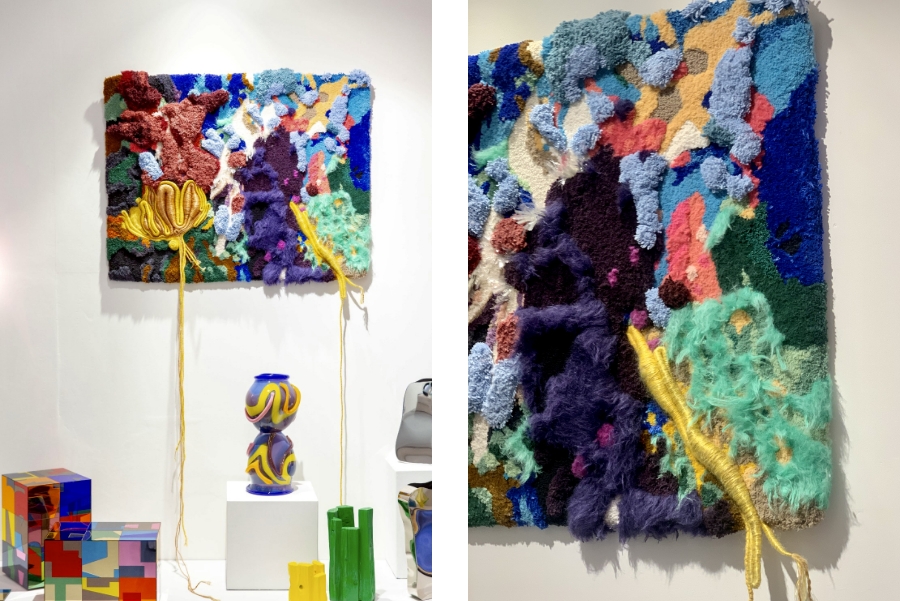
Sandra Keja Planken’s ‘Mythical Stuff’ at Isola Design Gallery in Milan. Photos: Sandra Keja Planken
From Vermeer to ‘Mythical Stuff’
For ‘Mythical Stuff’, Keja Planken was inspired by the work of Dutch artist Johannes Vermeer and, in particular, by Vermeer’s mother, who wove with cotton. Recycled cotton forms the basis of the work, creating a link with the textile traditions of Vermeer’s time. Keja Planken and the TextielLab worked together to explore new possibilities and integrate recycled materials that harmonise with the concept in terms of colour and composition. The experimental process involved playing with yarns, exploring collage and graphic techniques, and creating shine in the tufting.
“You normally tuft with wool, which is matte. With experts and product developers from the TextielLab, I started investigating which material would be suitable. It was a major experiment that lasted about six months,” she says enthusiastically.
“It’s important to understand how my work resonates with others and what emotions it evokes.”
Collective cooperation
Salone del Mobile offered the ideal opportunity to present ‘Mythical Stuff’ to a broad international audience, to meet otherprofessionals and make new contacts. She also had the chance to talk to Queen Máxima about the various materials used and the meaning of the work. She found it particularly interesting to observe the public from a distance at certain moments. “It’s fascinating to see how people react to my work and how they interpret it. It’s important to understand how my work resonates with others and what emotions it evokes.”
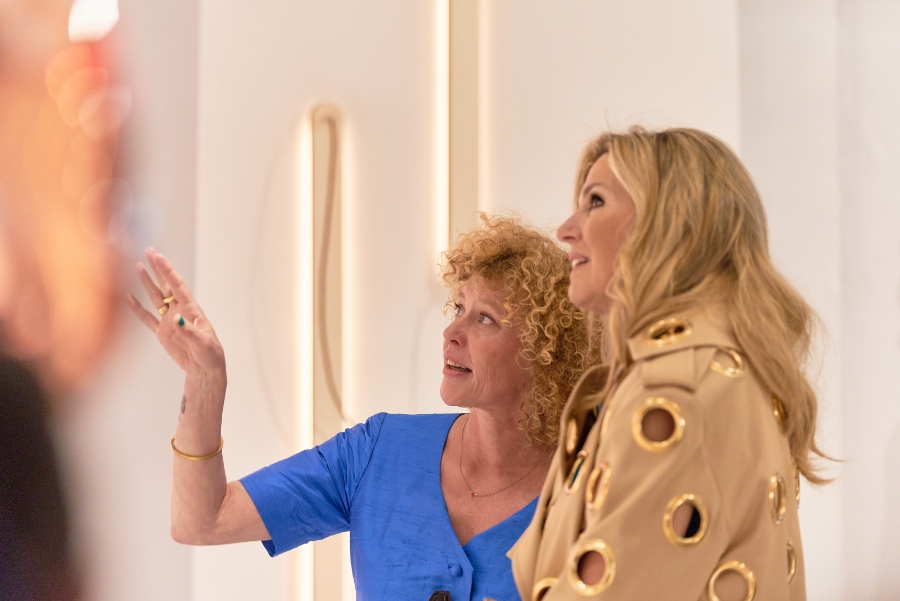
Sandra Keja Planken talking to Queen Máxima at Salone del Mobile 2023. Photo: Sandra Keja Planken
Her experience at the event also gave her a critical insight. “Milan was big and overwhelming. How can we ensure that next year we’renot just there as individuals adrift in a big sea, but as a stronger presentation and collective? That’s something I’d like to explore further. Collaboration and collective presentations can offer new possibilities for artists and designers.”
Interest
The presentation of ‘Mythical Stuff’ in Milan has attracted interest from galleries, magazines and other venues. Keja Planken continues to develop her creations and plans to produce new projects with the TextielLab and other partners.
Aleksandra Gaca’s innovative creations were the perfect combination of textiles, architecture and sustainability. In Milan, she presented her collaboration with Philips My Creation at Masterly. “Working with Philips My Creation offers an excellent opportunity to integrate my textural designs into products that are used every day,” she says.
Gaca is especially enthusiastic about the combination of 3D weaving and printing technology. Her textural designs can be printed on different lighting, in a variety of materials and colours. This development immediately allows her to see the application and collaboration of her work, which is a valuable combination for her as a designer, she says.
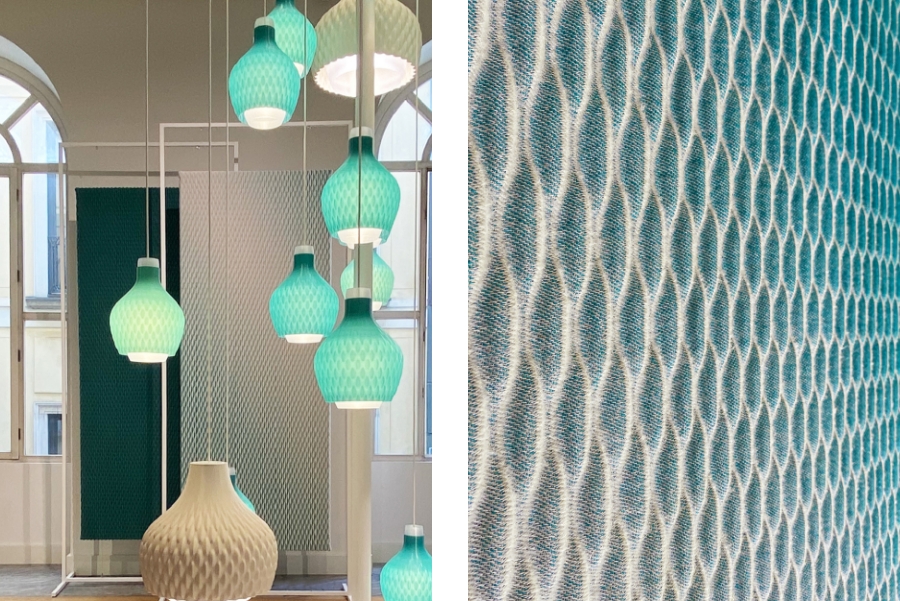
Presentation by Aleksandra Gaca and Philips My Creation at Masterly in Milan. Photo: Aleksandra Gaca
Gaca also worked with renowned Italian architecture studio Marcante Testa on the Campo Base project. She was invited to produce several fabrics for walls in the TextielLab. She developed the fabrics several years ago in the TextielLab and they are part of her permanent collection, so these days she mainly focuses on the colour gradient in the play of lines. Gaca has now been involved with the TextielLab for about 25 years: “What makes the TextielLab special is that it gives designers the opportunity to work on an industrial scale. It offers a place to develop and realise new textiles. To me it feels like a second workplace.”

Presentation by Aleksandra Gaca and Marcante Testa at Salone del Mobile in Milan. Photo: Helenio Barbetta
Taking part in events like Salone del Mobile not only offers Gaca the chance to showcase her work but also to gain valuable insights, inspiration and new collaborations. “Every time you give a presentation, you build new experiences and learnings for the next one,” she says. She notes the growth in her participation: over the years, her presentations have taken various forms, from group exhibitions and a solo show to several collaborations.
“It’s good to be where your work is, so that you can give advice or more explanation and can have a conversation.”
Although it can be an investment and take time to achieve concrete results, it is also essential for building a name and showing off what you make, Gaca says. Moreover, she recognises the benefits of being present at her shows: “If possible, it’s good to be where your work is, so that you can give more explanation, have a conversation or receive feedback from the viewer. That’s the value of going to Salone del Mobile.”
Artist and designer Sangmin Oh won over the public with ‘Knitted Light’. His sculptures, which bridge the gap between art and design, surprised and amazed visitors with their unexpected textile shapes and enchanting play of light.
“The reactions were amazing. People don’t expect this to be textiles, they were surprised how textiles could be displayed,” says Oh. His work, which was made on a flat knitting machine in the TextielLab but takes on a three-dimensional quality, shows how Oh plays with the elements and creates unique shapes.
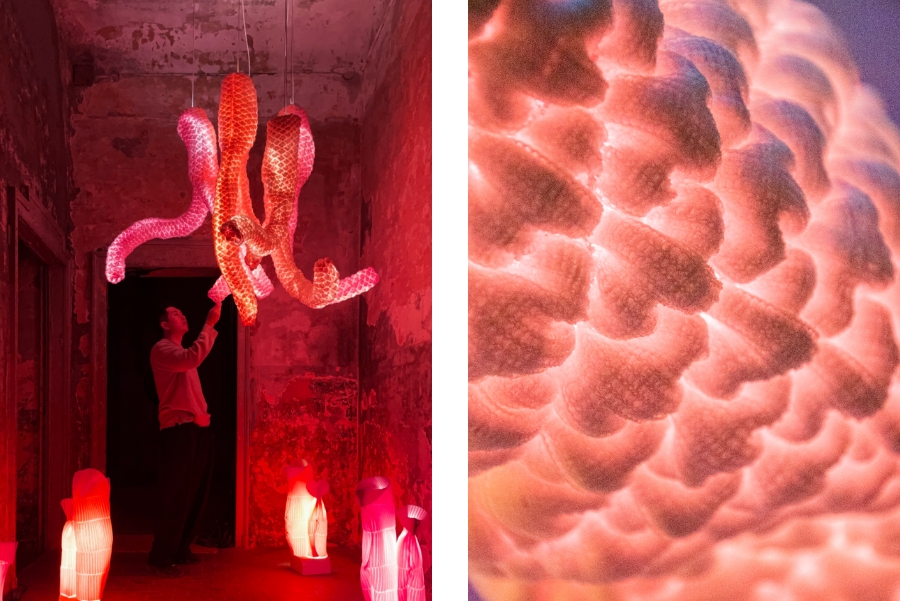
Sangmin Oh with ‘Knitted Lights’ at Salone del Mobile. Photo left: Osangmin Studio, photo right: Juliana Verastegue
“Milan was a very different platform to show the work, with more people from the design field.”
For Oh, the decision to attend Salone del Mobile was a conscious one. He saw it as the perfect opportunity to present his story and way of working to a wider audience. “Milan was a very different platform to show the work, with more people from the design field,” he says.
TextielLab’s role
The TextielLab played an important role in the creation of ‘Knitted Light’, providing space for discovery, experimentation, and trial and error. Oh also had the chance to work with materials he wanted to explore, such as monofilament and various yarns. By playing with these elements and with light, he produced unique textures and shapes. “A small difference makes a big difference,” he notes. Shifting the monofilament 0.1 mm creates an entirely new pattern. It took almost half a year to complete one piece for Salone del Mobile.
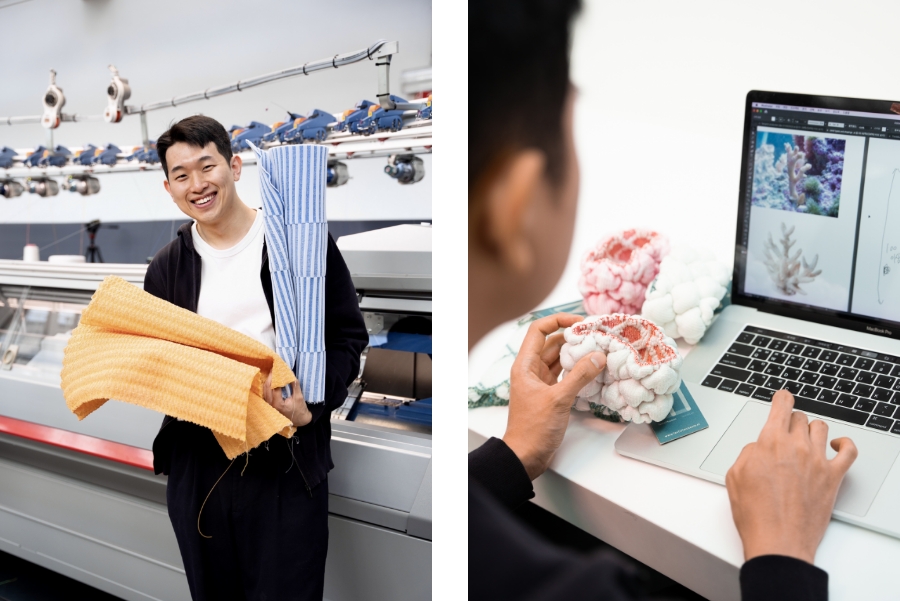
Sangmin Oh with samples from “Knitted Light” in the TextielLab. Photos: Patty van den Elshout
The power of storytelling
For Oh, ‘Knitted Light’ is more than just visual aesthetics. He wants to raise awareness about sustainability and climate change. His sculptures symbolise the changing colours in nature caused by rising sea levels and global warming. The use of glow-in-the-dark elements elegantly highlights the beauty of our natural environment. “I hope that ‘Knitted Light’ offers a new perspective on nature. I’ve always been fascinated by the power of storytelling,” he says.
Following his success at Salone del Mobile, Oh is looking ahead to his next collaboration with Rademakers Gallery in Amsterdam. He will also participate with the gallery in PAN Amsterdam, an annual art and design fair in November. In addition, Oh’s work was recently featured in Elle Decoration’s ‘Handmade’ issue. At the TextielMuseum, his work can currently be seen in Secrets of making #3, an exhibition for the whole family. Oh also plans to develop new pieces and experiment with artificial intelligence and interactive elements to create even more futuristic works.
Inspired by the Japanese art of origami, Samira Boon views folding textiles as a mathematical translation of natural processes and shapes. “Nature has optimised itself over the centuries,” she says. “The folding technique responds to this in a unique way and offers possibilities for flexible use of space.”
Her work led to the development of Archi Folds, the result of years of research and development that partly took place in the TextielLab. “It started on a small scale on a cotton warp but developed into a long-term research project and close collaboration with experts from the TextielLab,” she says.
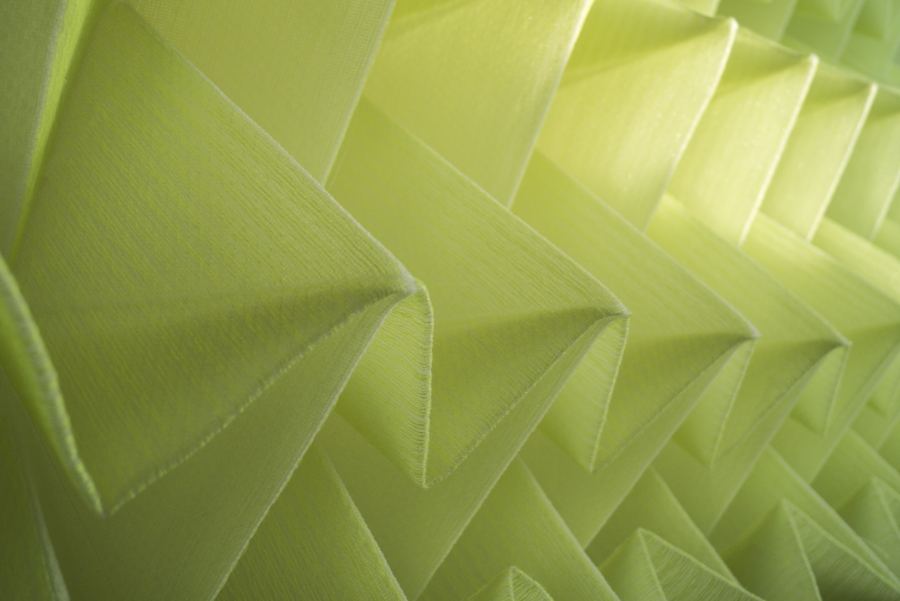
Close-up of ‘The Diamond Origami’. Photo: Studio Samira Boon
“Since recycled yarns have been on the market, we haven’t worked with anything else unless the project requirements don’t permit it.”
Cooperation
Translating the folding technique into computer programmes for the looms relies on knowledge that Boon has built up over the years with product developers and experts from the TextielLab. In collaboration with yarn consultant Vera De Pont, for example, they keep track of the latest developments in sustainable yarns. “I’m really pleased that we can now order recycled monofilament. That wasn’t an option 1.5 years ago. We’re constantly looking for sustainable yarns to produce our projects. Since recycled yarns have been on the market, we haven’t worked with anything else unless the project requirements don’t permit it,” Boon explains.
Salone del Mobile
Boon presented five projects at Salone del Mobile, including one of the highlights of Archi Folds: the Hermès commission. For Hermès Shanghai, Studio Samira Boon developed a 3D textile facade designed to create an intimate atmosphere in the shop and enhance the feeling of luxury. The textile installation has different degrees of transparency. The progressively transparent top section lets in natural light, while the denser weaves at the bottom ensure the shoppers’ privacy.
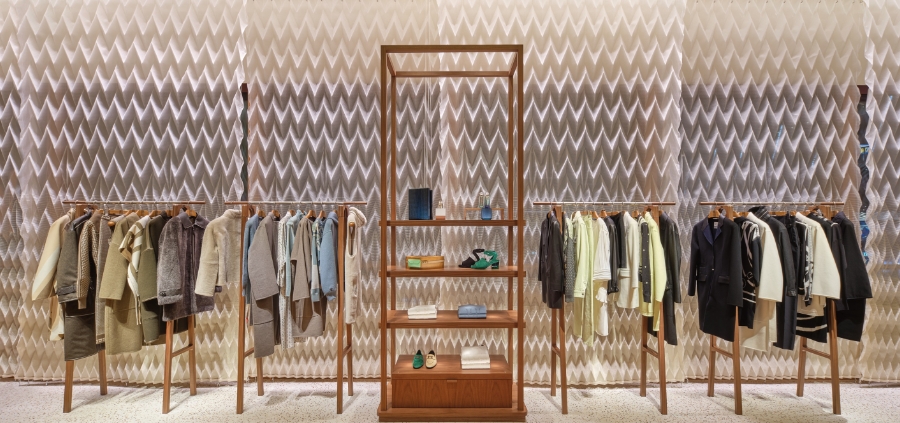
Textile installation for Hermès Shanghai by Studio Samira Boon. Photo: © Cai Yunpu
Boon’s presentations in Milan were enthusiastically received. “The response to our work has been overwhelming. We’re currently talking to potential clients who approached us based on Salone del Mobile,” she says. And there’s more to come: an exhibition in Soestdijk Palace in the autumn will also feature Boon’s work. “We make work that is continuously being applied. We’re currently focused on different locations; the work finds its way to the public.”